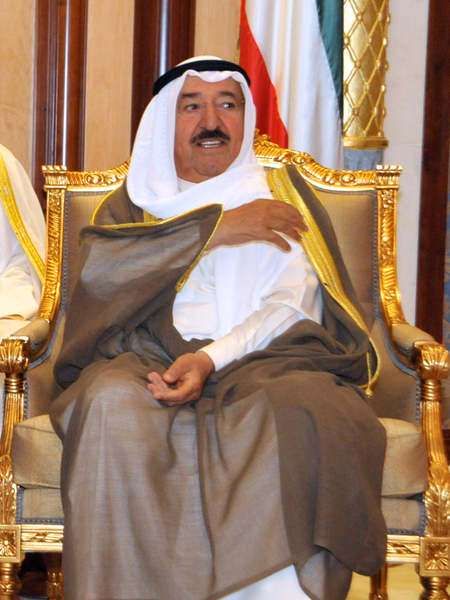The rulers of the Al-Sabah dynasty
1. Sheikh Sabah I Bin Jaber: 1756-1762
2. Sheikh Abdullah I: 1762-1812
3. Sheikh Jaber I: 1812-1859
4. Sheikh Sabah II: 1859-1866
5. Sheikh Abdullah II: 1866 -1892
6. Sheikh Mohammed I: 1892-1896
7. Sheikh Mubarak Al-Sabah: 1896-1915
8. Sheikh Jaber II: 1915-1917
9. Sheikh Salem Al-Mubarak: 1917-1921
10. Sheikh Ahmad Al-Jaber Al Sabah: 1921-1950
11. Sheikh Abdullah Al-Salem Al-Sabah: 1950-1965
12. Sheikh Sabah Al-Salem Al-Sabah: 1965-1977
13. His Highness Sheikh Jaber Al-Ahmad Al-Jaber Al-Sabah. The current ruler ascended the throne in January 1978.
In the 17th century, utubi, the union of Arab tribal communities, was supplanted by drought from Al-Aflaj to central Arabia. In Qatar, they studied navigation, and then scattered across various Arabian bays, after which they came to Kuwait at the beginning of the 18th century. They were founded here under the suzerainty of Bani Khalid.
The first exploration well was drilled in Bahrah during geophysical exploration. Oil was first discovered in Burgan in 1938. Due to World War II, oil export did not begin until 1946. After increasing export in the oil field, a town was founded for the staff of the oil company, named after His Highness Emir Sheikh Ahmad Al-Jaber Al-Sabah Ahmadi.
With the advent of roads, ports, factories, power plants and desalination plants, modern infrastructure has grown from a waterless desert. The arrival of thousands of foreign technical consultants and workers to service development plans has increased the population. Many Kuwaitis, members of the privileged minority, are in the new role of importers, contractors, landowners and government employees.
The role of government in the economy and administration has naturally grown under the influence of wealth and development. Modern business laws were promulgated. With the expansion of the government, a new administrative order was developed. Despite the fact that the Shura (council) has always been part of Kuwait’s political life since the reign of the first ruler of Al-Sabah, the government began to develop a new style of constitutional rule.
Although Kuwait has been an independent political entity for more than two centuries, it won international recognition as a sovereign state in June 1961. A few weeks later, Kuwait joined the Arab League. In 1963, the country became a member of the United Nations.
Revealing the past The oldest evidence of human existence in Kuwait was the Mesolithic tools discovered in Burgan and Wafra and dating back to about 8000 BC. No signs of a Late Neolithic were found in Kuwait, but excavations on the Kuwaiti island of Failaka give good reason to believe that Failaka was part of Dilmun, a Bronze Age civilization and a centre of international trade between 2200 and 1800 BC.
Stone Age Mesolithic Age (13000-8000 BC)
Tools of medium and small size, carved from stone and dated to the Mesolithic era are of interest in terms of penetration into the life of that era. These guns were used for hunting birds and small animals and were found in large numbers in Burgan. These guns were left in the bitumen deposits by groups of hunters who inhabited the Burgan basin on the mainland of Kuwait. Carved from transparent flint, these tools included arrowheads, knives, scrapers used to process wood and animal skins, as well as cutters for cutting gutters.
Age of the Neolithic (8000-5000 BC)
Al-Grain site, in southern Kuwait. considered one of the most significant sites belonging to this era. Another site in Sulaybikhat is considered a workshop. In both areas, arrowheads, scrapers and drilling tools were found.
Ubeyd period (4500-3500 BC) A unique site was recently opened in Al-Sabbiyyah on the coast of the Arabian Gulf. A large number of fragments of pottery belonging to the Ubeid culture types 2,3 and 4 were found there. Obviously, settlers in the northern and western regions of the bay contacted this culture and used similar types of pottery. A preliminary study of the fragments of pots showed great similarity with the finds in Dosariyyah, Abu Al-Khamis, Uruk and Eris. Double-edged knives, weights and flint beads indicate a primitive way of life in Al-Sabah. Given the small size of the plot, it was most likely seasonal parking,
Bronze Age (2300-1100 BC) Dilmun culture
The Bronze Age began when the people of the islands of this territory began to develop their marine culture. Later in this period, Dilmun, including Failaka, Bahrain and the coast of East Arabia, turned into an economic centre. Archaeological finds of this period were discovered only in two places - on the islands of Failaka and Umm-Namil. Many archaeologists are sure that Failaka was inhabited and was the northern trading point in the Dilmun kingdom, not only until 2000 BC. The oldest settlements on Failaka belong to the Dilmun culture, a section of which is located on the southeast coast of the island. The settlement included accommodation units (about 30 houses) and a square stone temple with characteristics similar to temples in Bahrain. It was built in honour of the god Iznik. To the west of the temple were public buildings and small rooms used as a warehouse or storage.
Kassite period (1500-1200 BC)
Around 1500 BC the cultural picture on Failaka has changed. The crisis period was replaced by construction activity. The ruined walls of the Dilmun temple were again reinforced with supports, and Inzak continued to be the main god. New housing was built on top of the old but in a completely different style. Pottery also took a different form. The traditional round Dilmun seals were replaced by cylindrical ones, most of which were made of simple earthenware. Others were made of blue glass imitating lapis lazuli prints.






.jpg)

No comments:
Post a Comment
Please Dont Enter Any Spam Link in The Comment Box